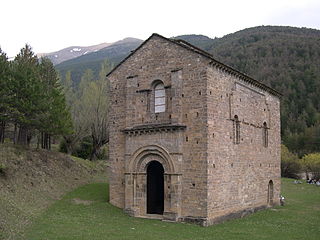
The White Towns of Andalusia, or Pueblos Blancos, are a series of towns and large villages in the northern part of the provinces of Cádiz and Málaga in southern Spain, mostly within the Sierra de Grazalema Natural Park.
Torre means tower in seven Romance languages and may refer to:

São Jorge Castle is a Moorish castle occupying a commanding hilltop overlooking the historic centre of the Portuguese city of Lisbon and Tagus River. The strongly fortified citadel dates from medieval period of Portuguese history, and is one of the main tourist sites of Lisbon.

An alcazaba, alcáçova or alcassaba is a Moorish fortification in Spain and Portugal. The word derives from the Arabic word القصبة (al-qasbah), a walled-fortification in a city.

Torre Alháquime is a village located in the province of Cádiz, southern Spain. It is home to a Moorish castle and cemetery.
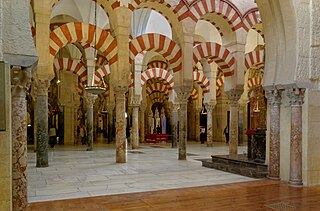
Moorish architecture is the articulated Islamic architecture of North Africa and parts of Spain and Portugal, where the Andalusians (Moors) were dominant between 711 and 1492. The best surviving examples are La Mezquita in Córdoba and the Alhambra palace in Granada, as well as the Giralda in Seville (1184). Other notable examples include the ruined palace city of Medina Azahara (936–1010), the church San Cristo de la Luz in Toledo, the Aljafería in Saragossa and baths at for example Ronda and Alhama de Granada.

Sierra de Cádiz is a comarca province of Cádiz.
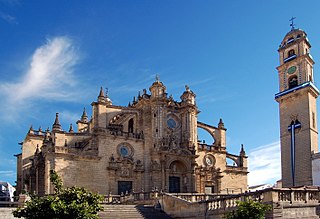
The Roman Catholic Diocese of Jerez de la Frontera is a diocese of the Latin Rite of the Roman Catholic Church. Its name derives from the localities of Medina-Sidonia and Jerez de la Frontera. This bishopric was erected the 3 of March 1980 by means of a Papal Bull, with the name of Asidonense-Jerezano, in memory of the old Asidonense Bishopric and because its present seat is in Jerez de la Frontera. The main temple of this diocese the Colegiata of San Salvador, today Jerez's Cathedral. The Bishopric of the Diocese is in Palace of Bertemati, in the Seat of the Stream. Asidonia-Jerez Seminary was founded in 1985.
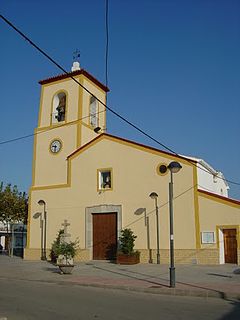
Torre-Pacheco is a municipality in the autonomous community of Murcia in southeastern Spain. It covers an area of 189.4 km² and its population in 2017 was 35,198. The only high ground in the municipality is Cabezo Gordo hill, the location of the protected Sima de las Palomas archeological site. The town has one secondary education institution, the I.E.S. Gerardo Molina.

Torralba is a municipality in the province of Cuenca, Castile-La Mancha, Spain. It had a population of 191 in 2004.

Fuentidueña de Tajo is a municipality of the autonomous community of Madrid, central Spain. It belongs to the comarca of Las Vegas.

The Castle of Jimena de la Frontera is a castle located in Jimena de la Frontera, Spain. It was declared Bien de Interés Cultural in 1931.
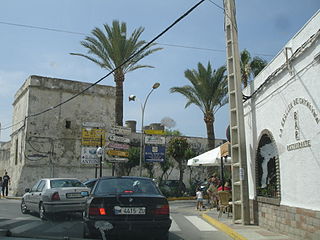
The Castle of Zahara de los Atunes and Palace of Jadraza is a medieval castle on Spain's coast. Located in Barbate and Zahara de los Atunes, Spain, it protected the local Almadraba tuna traps as well as having a wider strategic role.

The Castle of Torre-estrella is a castle located in Medina Sidonia, Spain. It was declared Bien de Interés Cultural in 1993.

The Torre de los Adalides was a rectangular medieval look-out tower of Islamic design located in the vicinity of Algeciras, Spain. It was situated roughly 1 kilometre (0.62 mi) from the coast on a hill some 100 metres (330 ft) above sea level in the area which is now covered by the city's northern suburbs. The tower was demolished by the Spaniards during the Spanish–American War as they thought the Americans might use it as a base of their own. The ruins of the tower are within military limits and cannot be approached without a formal permit.

An Albarrana tower is a defensive tower detached from the curtain wall and connected to it by a bridge or an arcade.

The Barchell Castle, located in the municipality of Alcoy, Alicante, Spain, is a 13th-century medieval building which stands on a rocky mound in the middle of a pine forest. It is next to the CV-795 road, between Alcoy and Banyeres de Mariola. It is located in the rural place of Barchell at 800 metres altitude. It is very close to the "Solanetes" which had a small population in the Muslim era.

The Castle of Cocentaina, located in the municipality of Cocentaina, Alicante, Spain, is a 14th-century medieval building which stands on a rocky mound of 765 m. The castle structure, recently restored, is one of the town's symbols. The tower is a square two-story structure. On the first floor there is an open patio with a well, a chapel and a warehouse. On the upper floor, where the lords lived, there is a cornice with battlements and a path for guards. The castle is a good example of military gothic style.



